
Many aspects of global warming’s alleged “settled science” remain in dispute but, for the sake of argument, let us accept the supposed consensus of the climateers and proceed to examine what the Paris Agreement offers by way of a solution to the purported threats.
According to the recently released IPCC SR15 report, the planetary thermometer is likely to soar over the next 30 years, prompting extinctions, weather extremes, famine, epidemics, border-busting waves of “climate refugees” and, just for good measure, hermaphrodite clownfish. If we are to avoid these calamities, again according to the IPCC, net CO2 emissions will need to decline about 45 per cent by 2030 and reach net zero by 2050. This must then be followed by the removal of carbon dioxide from the atmosphere to get the presence of that trace gas back to a “just right” level, whatever that might be.
I believe there are plenty of reasons to be sceptical of their predictions but, again for the sake of the argument, let’s assume they are correct and look at the targets proposed to deal with it. While there are plenty of facts we can quibble over, there are still plenty of things to agree about.
I present below (Figure 1) a rather old (2011) prediction of projected carbon dioxide emissions from three emitters, Australia, United States, and China. In 2006 China did indeed overtake the United States as the world’s major emitter.
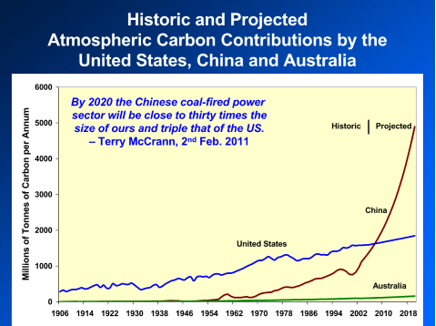
And, by 2016, Figure 2 shows that China was indeed closing in on double the emissions of the USA, and that their emissions were still rising. Australia still dragged its feet on around one per cent of total world emissions.
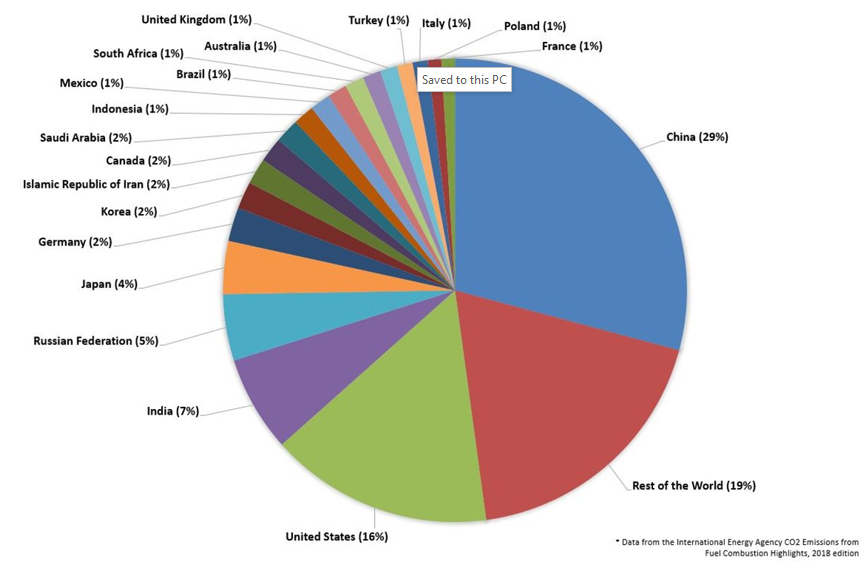
But we move on to 2018, and Figure 3, for a more recent update.
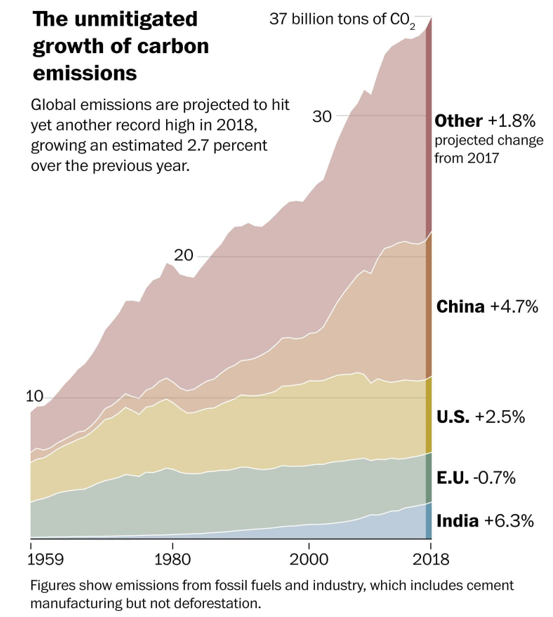
There are three “take home” messages to be seen in these three figures.
Firstly, on close examination of Figure 3, you can easily see that over the 38 years from 1980, the EU’s emissions declined by just a little. On the other hand and over the same period, US emissions were also almost flat. Add the EU and US emissions produces a total of around 10 billion tons in 1980, and only a little less in 2018. “Other” is also relatively flat, going from around 9 billion tons to 15 billion tons over the same period and clearly overtaking the combined EU and US score.
However, the most significant players in the climate change narrative are China and India, both of which dramatically ramped up their carbon dioxide emissions and continue to do so at the rates of 5 per cent and 6 per cent per annum respectively. Both China and India have made it very clear the urgent needs of their people preclude any possibility of contributing to emission reductions during the Paris accord’s initial commitment period, which ends in 2030. Instead, China has announced its intention to increase its 2010 emission levels by between 50 and 100 percent, while the International Energy Agency predicts that emissions from India will treble over the 2010-’30 period. This proposed increase is authorised by the IPCC under the Paris Agreement.
The second “take home” message we should also note from Figure 1 and Figure 2 is that between 2010 and 2016 China’s emissions grew every year by more that Australia’s total emissions. And that at 2018 it continues to grow at 5 per cent. If Australia were to achieve a 100 per cent reduction in its carbon dioxide emissions overnight it would only delay the IPCC-predicted Climatageddon by just twelve months.
For all the pain that Australians would suffer, that is pretty well the very best case scenario the world can expect from our sacrifices: a one year reprieve!
The third lesson to be gleaned comes from Figure 3, which shows the EU, even after the expenditure of hundreds of billions of euros invested in renewable energy technologies over the last three decades, has only managed the most minor of reductions in emissions — a reduction totally dwarfed by the increases in carbon dioxide coming out of China. There is evidence a good proportion of the reductions achieved by the EU are largely due to transfers of manufacturing industry to China, where restriction on emissions are not necessary. This means even these reductions in emissions by the EU are largely illusory. Indeed, the EU’s embrace of renewables haven’t even cancelled out India’s increase! The huge expenditure and almost negligible reduction in EU emissions should be ringing alarm bells for all those economists who attempt to do cost-benefit analyses. What cost should we bear for a one year reprieve? The EU and the US could of course reduce their emissions for a further minor delay, but while India and China are allowed to continue increasing their emissions a delay is all that can be achieved.
Having looked at the above figures I decided to amend Figure 3 with a quick and dirty projection of what the major players have said that they expect their emissions to be in 2030. The result ius presented it below as Figure 4. In the figure China doubles its emissions, India trebles its. Europe and USA make no significant advance on reductions – a reasonable assumption for a twelve-year projection, since they haven’t made any significant reductions in the last thirty to forty years. Other? It’s hard to believe that they won’t follow China and India’s lead and aspire to increase their emissions, After all, many of the “Other” nations are “developing nations” with arguably an equal right to increase emissions as China and India. Being generous, I am here holding their emissions constant at 2018 levels.
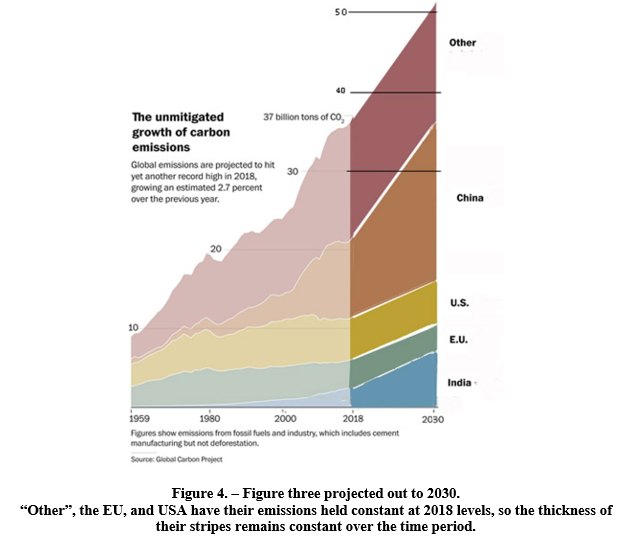
As Figure 4 shows, we are looking at a probable 35 per cent increase in emissions by 2030.
But now here is the critical point: according to the IPCC’s SR15 report, as mentioned above, if we are to avoid their predicted calamities, net CO2 emissions will need to decline by about 45 per cent from 2010 levels by 2030, reaching net zero by 2050. Is this even possible? We have seen have seen that the Paris agreement allows India and China to continue to increase their carbon dioxide emissions at least until 2030, and who knows what after that?
Now let us also consider the fanciful scenario where the EU and the United States (and throw Australia in there as well) all cut their emissions to zero by 2030. I present this scenario as Figure 5. In such a case the total global carbon dioxide emissions would still be rising quite strongly, with an increase of 10 per cent over the twelve years. The target 45 per cent reduction from the 2010 level by 2030, is simply dreaming.
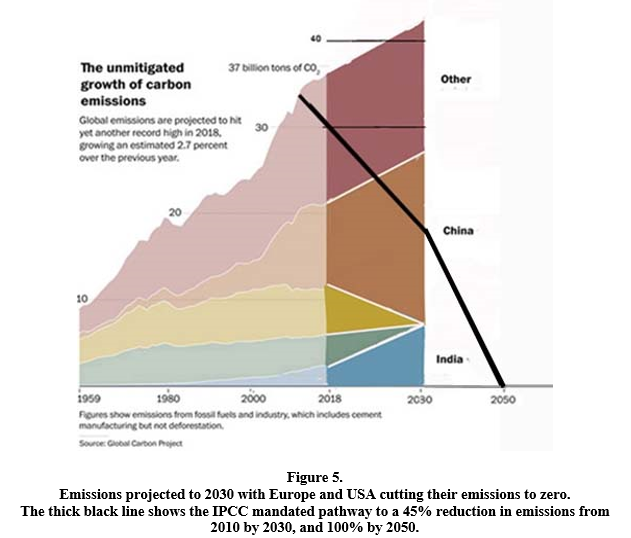
Even if “Other” were also to cut their emissions to zero, the 45 per cent reduction target remains quite simply unattainable. The thick black line in Figure 5 shows the IPCC’s supposed target of a 45% reduction of emissions from the 2010 levels by 2030, and 100% by 2050.
The reality is that Europe, the US, and Australia, or indeed any other nation outside India and China, cannot really prevent an increase in global carbon dioxide emissions – they can only delay the IPCC-predicted Climatageddon, and surely the IPCC knows this. Given that the IPCC’s targets are obviously unattainable should make one wonder why the “brightest minds” in Australia continue to treat the Paris accord as holy writ.
The IPCC’s modelled pathways show that US $2.4 trillion must be invested in new clean energy every year from 2015 through to 2035, which, Bloomberg notes, is an almost sevenfold increase on the $333.5 billion invested in renewable energy in 2017. Is this affordable? In total, we’re looking at aggregate investment of $48 trillion. The interest bill alone (at say 5 per cent pa) would be $200 billion per month – more than the whole world currently spends on childhood education and environmental protection combined.
All this pain for no gain on behalf of a project that is demonstrably unattainable!
 Sign In
Sign In 0 Items (
0 Items ( Search
Search









Well enough put here, Alistair, although we are dealing only in ambit claims and straw men. The underlying threat is a deliberate, forced reduction in demand with its’ concomitant severe reduction in living standards. For those who have the financial capability, or sufficient political power to ensure that capability, squads of diesel generators are already in place – Adelaide, Melbourne, Sydney, Brisbane.
As a minor but pertinent comment, *please* relabel your graphs and figures as “The unmigitated growth of carbon dioxide emissions”. While I’m sure you know the difference between a solid and a gas, or an element and a compound, a lot of people simply don’t (or don’t care) and the propagandists exploit this without shame, with the end result that a common misconception is that black, sooty particles are released into the air without control from the coal-fired generators.
Let’s see what the expert in all science (especially weather, atmospheric physics and power generation) Ian Mac has to say.
I’ve pointed this out to anyone who went on about this to me. The only thing we can hope for is that the feedbacks will tend to be negative, and that the models will prove to be as biased as the “nuclear winter” ones. Quite likely actually, given their performance over the last 20 years.
Alistair,
Your Carbon will be returned to the atmosphere when you are burnt at the stake for heresy. Your main crime is bringing facts to the attention of the Klimate Kon Kult (KKK for short) who brook no opposition to the mantra. Like many, I am still breathlessly waiting fr St. Greta the Grim t park her bottom in Beijing and berate the Politburo.
Excellent article which the trolls (like Omm! Omm! MacBot) will denigrate, but not challenge as arithmetic and reality have never been strong points among cultists or climateer pseudo-scientists. It is the feeling, the virtue signal and the subsidies and grants that really count, never reality.
Cue Stage Left as the chanting MacBot enters and adds irrelevant comments longer than your article.
This article is pure verbal dysentery. The greenhouse effect of CO2 is saturated at the present level and beyond.
Good point ianl about the deliberate confusion of C with CO2..
It is an argument that is well thought out and well presented, Alistair.
Unfortunately, all this talk about “emissions” is completely irrelevant. CO2 has no relationship with the weather (and for that matter, burning stuff has no relationship with the ratio of CO2 in the atmosphere relative to the CO2 in the sea. Hook’s Law makes that determination).
A new paper by O.M. Pokrovsky demonstrates that the GIGO general circulation models nonsensically ignore the changes in cloud cover. “Thus, cloud cover changes over three decades during the period of global warming can explain not only the linear trend of global temperature, but also a certain interannual variability.”
http://joannenova.com.au/2019/11/new-study-settles-it-global-warming-and-the-pause-was-driven-by-changes-in-cloud-cover-not-co2/
When one considers the opportunity cost of the eye watering sums of taxes spent on this folly it is enough to make you weep. Just the lower standard of living imposed on all Australians as a result of higher energy costs is a disgrace let alone the foregone uses all that money could have been put towards.
And another billion wasted. This done just before a report on the sorry state of aged care which no doubt could use a billion or two.
I can’t see this insanity ending in Australia. It will be played out to the bitter end and we have no one to blame but ourselves. After all we get the government we deserve.
Hook’s Law rod.stuart? Perhaps you mean Henry’s Law.
Sorry Biggles. Senior’s moment.
What! No contrarian response from the Doogle.
The claims made in relation to climate change range from mild to near hysteria. And the customary opportunistic vandalism.
It is breathtakingly arrogant for those of this millennia to make such claims after a mere 200,000 years of known human habitation on the planet with evidence that major climate changes of far greater significance occurred long before man had evolved.
They were very clearly major changes that induced the planet as we, of this millennia, have found able to support massive populations.
Some will argue, we are at the limit. Yes, deserts have increased in more recent millennia. On what basis? Some relatively random selective measurements, too often shown to be ‘convenient’. Change is endemic to the planet.
It’s been whatever it is way back as has been expertly identified; ice, floods, animals etc across millennia but we have this extraordinary conceited arrogance that places the climate change remedies that many claim are absolute in achieving favourable outcome.
In the short time we have been on this earth, about 200,000 years, by the most recent estimates, the current cult is to believe absolutely in our own relevance and capacity to influence.
Everybody knows that whatevers gonna happen is gonna happen.
Even the behaviour of the most fanatical climate zealots shows they don’t really believe their own predictions.
We’ve passed so many hypothetical tipping points now that anyone who’s listening has concluded that note we can do nothing to change the climate.
The truly appalling thing is that they’re spending the earth’s resources on the ideological goal of crippling efficient energy production instead of adapting to the disaster they want us to believe is happening.